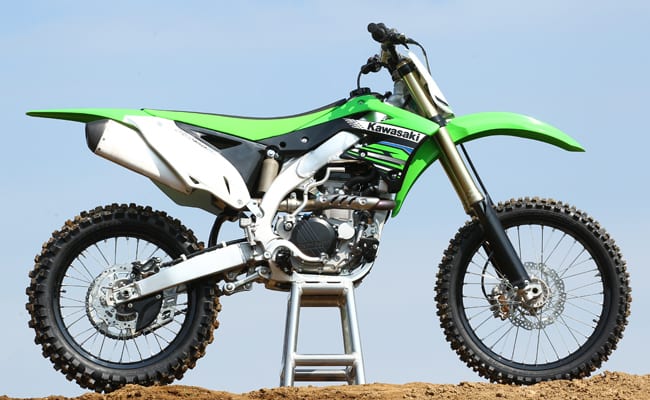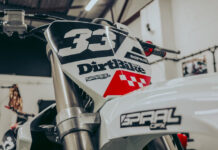Is Kawasaki the first of the Japanese Big Four to really step up their game since the arrival of KTM’s 350? It certainly feels like it. No doubt about it, KTM’s 350 has shaken up the market and given motocross clubman around the world an exciting and different option when they consider buying a new bike in the MX1 class. Judging by the number of those orange 350s you can see bombing around at regional races it looks like it’s an option many racers are taking.
It’s a pioneering move by KTM which at this moment in time appears to be paying off – especially considering they are also still churning out a 450. Right now there’s no sign of any of the Japanese manufacturers following suit with a 350 but there’s definitely enough evidence from Kawasaki’s 2012 KX450F to suggest they’ve taken note of the characteristics of the 350 and appreciate that maybe a smoother, easier to handle bike is what’s needed.
Let me start by saying right off the bat that this bike is a big improvement on previous KX450Fs and in so many areas. There’s been a whole host of changes and improvements that effectively make this feel like a completely different bike. Apart from the suspension which has only had minimal upgrades it’s as good as a completely new bike from the ground up and a much more consumer-friendly motocross bike for it in my opinion.
Take the ergonomics for example – there’s been a huge improvement in this department. The bike now has a much slimmer and flatter feel and it’s much easier to shift your weight around but Kawasaki haven’t stopped there. They’ve really thought about this. What they’ve done is give the rider options by introducing adjustable footpegs and four alternative handlebar settings to allow vertically challenged figures like me right through to bendy beanpoles like Peter Crouch the opportunity to get the bike more suited to their needs.
The handlebars are set as stock on the second option forward which means you can move them 10mm back or 15mm to 25mm forward. The footpegs can be lowered by 5mm and although that doesn’t sound much believe me it makes a substantial difference, especially if you’re tall. Even if you’re not on hard pack corners it gives you that slightly lower centre of gravity to push on the outside peg, giving you more confidence and traction. If that’s still not enough to tailor it to your needs there’s an optional rear suspension rod which is 1mm longer. Again, it doesn’t sound much but what that does is lower the bike by 4mm at the centre of the seat. True that still doesn’t sound much but you’ll be surprised how much you’ll notice the difference in the feel when riding.
The whole bike feels easier to throw around and the new slimmer design definitely helps. The rad shrouds now seem to start off narrower between your legs and then project out in a straight line as you slide your leg forward – that balloon shape effect as they wrap around the radiators has gone and that’s a good thing. Especially when sliding your leg back when hanging it out in corners. Not only that, they have improved airflow and look sharper – so that’s rad, rad scoops then!
In fact the whole bike just looks slicker with new side panels, a much improved rear mudguard and more seamless joins. Add the bling blue anodised hardware parts like the fork caps, oil caps and plugs on the side of the gearbox and a little dash of blue in graphics and you’ve got a bike that’s more attractive than before and let’s be honest we all look for that. The new seat finishes off the look but that’s not just cosmetic. Finally, finally, it seems that Kawasaki have made a seat that won’t blow out soft. It’s flatter, slimmer and not so deep and my god it’s better for it.
The improved new seat sits upon a new, smaller fuel tank which is down from seven to 6.2 litres, is 100g lighter and sits 20mm lower at the top which all helps give the new improved feel. The aluminium perimeter frame is still made of forged, extruded and cast parts but is also a new design that is 4mm slimmer across the widest part of the two down tubes. They too have had been worked internally with new cross sections that give more flexibility at the top but more rigidity low down between your boots where the frame actually widens to give better grip and a more solid feeling landing off jumps. The frame narrows at the bend below the seat to give a better riding position and compliment the rad shrouds.
There’s new Uni-Trak rear suspension which mounts lower under the swingarm than previously, giving the bike a longer rear suspension stroke and allowing for more precise shock tuning which is obviously a plus. The tie rods have less rigidity which helps give a smoother feel and get power to the ground.
Another positive improvement are the forks. I reckoned the dual chamber effort was the bike’s weak point for 2011 – they were just too soft and I felt you certainly had to take Kawasaki up on their option of the stiffer spring. Well, I’m pleased to say that’s not the case this year. They still come with the diamond like carbon (DLC) coating on the outer of the sliders and have the Kashima coating on the inside and I have to say they are plush and give you confidence (even with a new slimmer Bridgestone front tyre that rolled its knobblies all day – sounds painful and at times it was)…
The lower triple clamp now splits at the rear and not on the side to give a more rigid and assertive feel through the bars. The most important change to the suspension though is that it’s better balanced between the forks and the shock and the stock settings are at a stiffer starting point. I think they’re pretty much bang on for the average rider whereas before you had to stiffen the bike up a lot more on the clickers (especially if you didn’t change the fork spring) and before you knew it you were running out of adjustment.
So it looks better, it feels and handles better but is the motor better? In a word – yes! It’s much smoother and less tiring to ride. Kawasaki have achieved this with a whole host of changes to the motor and ignition. The most revolutionary of which is the new launch control, a first for a stock motocross model.
Kawasakihave really gone to town on the ECU for 2012 – not only have they fitted the launch control but they’ve also given the rider three easily replaceable mapping options. For me this combined with the adjustment of the ergonomics is a real winner. You really can cater a bike closer to your style of riding than ever before.
The launch control is brilliant and definitely works. Just press the button on the left side of the handlebars until it starts flashing to tell you it’s enabled, then go through your usual start routine only with less fight to keep the front end down. In fact, it’s the complete opposite and it’s actually harder to get the front end to rise up. It only works in first and second gear then once you hit third it switches off automatically. It really does make a difference and bearing in mind the start is such a critical part of the race it’s a masterstroke.
The adjustable mapping is so easy to change that a chimp could do it – and not even a trained one. The four-pin DFI couplers come in three easy colour choices – white (soft terrain), green (standard) and black (hard terrain) – that you simply plug in from easy access on the side of the headstock. Like the launch control you really can notice the difference and, get this, you can even easily fine tune each one of the three colours to your own personal needs through Kawasaki’s KX FI Calibration kit and your laptop giving you even more set-up options. It even has fancy 3-D mapping charts…
In the motor there’s a host of changes to sync up with the EFI and ignition and improved reliability to handle the change in the power curves. There’s a new bridged bottom piston (the industry’s only mass produced) that’s stronger and gives more mid-range power and it also has a thinner top ring. A new intake cam has a 0.4mm higher valve lift that allows more air in to improve low to mid-range performance. The wedge-shaped crank web reduces engine vibration and helps give the bike this new, smoother power delivery.
The gearbox has also had an overhaul to match the wider powerband. They’ve increased the dogs and slots from three to four and altered the angles so there’s less chance of a missed gear. The first gear is now 12mm and not 9.2mm and therefore more durable (although to be fair, I hardly used it). The shift fork stroke is now 4.4mm and not 5.3mm which lightens the load when shifting and gives a more positive feeling.
A complete new exhaust system has been designed to suit the improved engine but also mass centralisation has been considered. There’s now a 60mm shorter, stockier tail pipe and the stainless steel header pipe is now tapered to increase the mid to top-end RPMs. Add that to changes made to the motor and features like the 43mm throttle body that uses two link shafts which opens the throttle more quickly after the 3/8 position and various other little tweaks and you’ve got yourself a sharp, responsive and easy to manage powerplant.
The brakes are pretty much as they were apart from the introduction of a wavy front disc. Could they be improved? Yeah of course – most things can – but for the time being they’re still strong and certainly enough to stop a club racer in a hurry. The clutch also has a nice feel made smoother by a revised spring rate and that smooth feeling seems to be the overriding factor of the 2012 KX450F.
Simply put it’s a much improved motocross bike. It’s been made easier to ride without any compromise on the power output and credit to Kawasaki for that. The adjustment made available to the rider is the real plus for me though. The adjustable mapping is quick and easy to change and, more importantly, it works. Add that to the fact that you’re able to fine-tune your riding position without spending a fortune and you’ve got a virtually fully tailorable machine…
Specification:
KX450F
Capacity: 449cc
Bore and stroke: 96mm x 62.1mm
Transmission: Five-speed
Fuel tank capacity: 6.2 litres
Front suspension: Kayaba 48mm (314mm travel)
Rear suspension: Uni-Trak (315mm travel)
Front brake: 250mm disc
Rear brake: 240mm disc
Seat height: 955mm
Wheelbase: 1480mm
Ground clearance: 330mm
Kerb weight: 113kg









